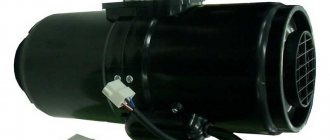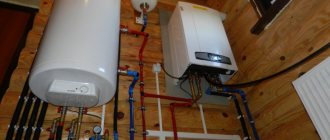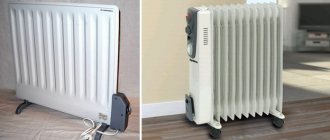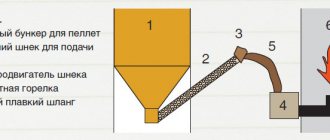PROBLEM:
1. When installing the central tunnel from the GAZ 3110, I dismantled the air duct directing air to the feet of the rear passengers, and this winter, the rear passengers on long trips began to complain that their feet were freezing, while in front - “Tashkent”.
2. Also, in order not to heat up the tunnel in vain, but to direct all the warm air to the legs in front, I plugged the outlet leading into the tunnel.
3. After modernizing the cooling system, the antifreeze pressure increased significantly, this became another reason in my decision (since I did not have to install an electric pump)
SOLUTION:
Install an additional interior heater.
IMPLEMENTATION:
1. First of all, I ordered the heater itself from Blagoveshchensk (a border city with China) - with delivery it cost 1,300 rubles.
There are a lot of analogues sold on AVITO, at exorbitant prices on the market.
From the heater parameters:
Height - 80mm (fits perfectly and does not interfere with chair adjustment) Airflow - 3 12V fans, 4 nozzles on the opposite wall Radiator - aluminum Pipes - 16mm copper.
1. The heater itself was tried on differently under the front passenger seat
1.1 If you place it offset back (into a recess), then a large heater will fit there (120 mm high), but the rear passenger’s feet will rest against the nozzles (unless you want to fry someone) + the aesthetics of the interior are violated 1.2 In the middle position, the heater does not interferes, is difficult to install, but the seat stops adjusting (it rests against the heater) 1.3 The front position is the most optimal - it doesn’t bother anyone, the seat is adjustable, not visible to passengers - and it’s also very convenient to mount on a body stiffener
2. Connect an additional heater in series with the main heater (did without draining the antifreeze)
Salers-technology silicone hoses
with a diameter of 16 mm, remaining after installing silicone on the entire cooling system. + one silicone corner 90 degrees and a 16mm connecting tube.
The function of warming up the interior and maintaining it in a comfortable thermal state is assigned to the standard heater. The principle of its operation is extremely simple - the heat from the radiator heated by the coolant is dissipated by a fan inside the car. The higher the speed, the more it heats, and at idle, if you please, only weak heat will emanate from the depths of the grilles. It will go to zero anyway, but what about minus?
Do-it-yourself primitive heating of the interior of any car in winter: current technologies
Fan heater
Those who like simple solutions will like additional means of heating the interior. Designing a car heater from a cigarette lighter with your own hands is one of the simple and affordable options for designing additional heating. The advantages of such a device are difficult to underestimate:
- Fuel and oxygen are not burned.
- Possibility of use in cars of any class.
- Compact design.
A similar solution is commercially available. Its name is a 12 Volt car fan heater. The main disadvantage is low efficiency: it cannot create a microclimate alone. It is recommended to use the car heater only as an addition to standard heating devices. Yours is more reliable and, moreover, repairable - all by analogy with winter washers: a homemade anti-freeze recipe is much better than a roadside canister of an unknown potion.
Ceramic oven
Using combustion gas as a heat source is an effective way to quickly raise the temperature to comfortable levels. The minimum elements are a ceramic stove and a 15-liter gas cylinder. The risk of fire and intense oxygen combustion limit the demand for this type of heating.
Modify the factory furnace
It is preferable to take the path of improving standard equipment, but the costs are incomparable. Modifying a heater is not an easy task: it requires skill and the elements are compact in size. It is not a fact that an additionally installed radiator will have an effect, since it is difficult for the fluid to warm up to operating temperature. Another thing is to introduce an electric heater from a diesel modification (RTS) - the effect is obvious. In addition, warm air flows immediately after starting the engine.
Features of operation
What you need to consider when using the device to prevent its accelerated failure:
When buying such a system, you need to carefully study the installation features, as well as use
Carefully read all the manufacturer’s recommendations, pay attention to the power parameter of the device itself. In the event that the power of the system does not correspond to a similar parameter of the on-board network of the machine, the installation of such an AO is not allowed, since it may cause problems. Every time you put the system into operation, you need to check its functionality.
Make sure there are no leaks or any damage. When using a gas-type heater, during installation, make sure that fuel does not leak out. A gas leak can lead to poisoning of passengers and the motorist. Never turn on the heating system to maximum mode. Remember that excessive heating of the air flow can lead to deterioration of health. This is because the heated air will be very dry, and accordingly, you will need to ventilate the interior more often.
How to make a car heater with your own hands and power it from the cigarette lighter: instructions
The operating principle of fan heaters is based on the formation of a heat flow by blowing a heated body. The air flow is generated by a fan, and a ceramic heating element acts as a heat source. Previously, there were models with tubular electric heaters and nichrome spirals.
Selection of components
You can create additional heating for the car interior in winter using improvised means. One of the simple schemes includes components available to any inventor:
- IP65 electrical junction box which serves as housing.
- Nichrome spiral for a household electric oven, acting as a heating element.
- Two axial fans.
- Two terminal blocks for fastening sections of spirals and tying them with connecting wires.
- Wire with a cross-section of at least 2.5 mm2.
- Cigarette lighter connector.
- Switch button.
Spiral
When choosing a ferronichrome spiral element, you must be guided by its cross-section. It is not recommended to choose products with a diameter of more than 0.6 mm. The optimal diametrical characteristic is 0.6 mm - and can be easily found on sale, and the connection diagram is simple. We will adhere to this advice when designing the electrical part.
For your information. You can take a nichrome spiral from a toaster, microwave or convection oven by measuring its diameter and adjusting the design of the device.
Cooler
Small fans can handle the heat dissipation function. The specific size depends on the dimensions of the junction box. For example, for a box 88x88x60, two coolers 30x30x15 are suitable. Of course, the electric motor must be designed for 12 Volts.
Manufacturing
When creating a heater circuit for a car with your own hands, powered from a cigarette lighter, it is important to understand that its electrical resistance depends on the length of the section of the nichrome spiral, which affects the amount of current consumed and, as a result, the amount of heat emitted. The larger the length and cross-section, the lower the resistance of the conductor and the greater the power of the installation.
It is important not to overestimate the scheme here. The standard cigarette lighter power circuit is designed for no more than 15-20 Ampere load. Based on this, we construct a scheme, taking into account the following aspects:
- Number of spirals – 5.
- The length of the spiral element is 20 cm, diameter is 0.6 mm.
- Two sections are powered in parallel: one consists of two series-connected spirals, the other – of three. The first is located closer to the fans.
Installation of spiral elements is carried out in “terminal blocks”, the connection to each other is also made through the holes of the terminal clamps with pieces of wire. At one of the ends of the distribution box, a cutout is made for the fans, which are glued together and glued to the body. On the opposite side there is a window through which air will escape from the product. You can use a drawing as a visual aid.
Attention! The presented circuit is designed based on the use of only a nichrome spiral with a diameter of 0.6 mm and a length of 20 cm. For other characteristics of the heater, it is necessary to design a different electrical circuit.
In fact, the power of the device is about 150 W. Current consumption is 13 A. A more powerful device involves the use of spirals with a diameter of 0.8 or 1.0 mm of a similar length. Connecting such installations to the cigarette lighter socket is impossible - the product is connected directly from the battery through a 30A fuse and relay.
Connection
According to preliminary data, each heater circuit will have a load of about 20 A. The first circuit allows you to connect the air heater not through the computer, but directly through a latching button and relay. The control wire to the relay can be taken from the fan. That is, to turn on the electric heater you will need to press a button and turn on the fan. Shutdown is controlled manually!
It should be understood that when all three circuits are turned on, such an electric hair dryer will consume a large amount of current, which is not so much at idle, and even more so in cold weather. Therefore, adding intermediate power levels may be considered. If you use two buttons in the circuit, then the first will include 2 circuits, and the second will include a third. And if the control signal is taken from the glass heating, then there will be a shutdown timer.
Total
Supplementing the standard interior heating in winter with a homemade car fan heater is one of the simple solutions. It is easier to implement than installing heated seats on a low-spec Lada Granta. The importance of a heating installation in creating an internal microclimate is exclusively auxiliary due to the low efficiency of such heating. The advantage over store-bought options is reliability, lower cost, and maintainability.
The product is assembled from nichrome spirals with a diameter of 0.6 mm, fans, terminal blocks, wires, a cigarette lighter connector and a button. Most of the elements fit into the case. Power is supplied from the cigarette socket. Current load – no more than 15 A. Effective power – about 150 W.
An alternative solution is to make a car heater from a hair dryer. The product’s motor is designed for 12 V. The heating elements will have to be cut into several sections and connected in parallel, having previously measured the current strength. The hair dryer should be connected exclusively via a relay.
Waiting for many hours in a car in a traffic jam or, worse, spending the night in an open field in the cold inevitably leads to the idea that an autonomous interior heater is by no means a whim of a hunter-fisherman or an attribute of a professional driver’s motor home.
Car interior air heater
Is a leader in choosing professional drivers. The cost of purchasing and installing an autonomous air heater is approximately half the cost of fuel used to warm up the interior during a year of operation of the tractor.
The structure and design of the air-powered autonomous interior heater is, in general terms, similar to a primitive starting heater. Unlike the latter, an autonomous heater uses air for heating and is installed directly in the cabin or interior of the car.
The heat generated by the combustion of a small amount of fuel in the combustion chamber is transferred through an aluminum heat exchanger to the air flow forced by a low-noise fan into the cabin. Combustion products are discharged through a metal heat-resistant hose outside the cabin. The fuel is stored in a tank, usually located on the rear wall of the tractor cab. A control panel and an air intake regulator are installed in the cabin. On average, an autonomous device consumes 200 ml of fuel per hour with a battery load of 40-50 W. Thermal power ranges from 2 to 7 kW/h.
Modern long-haul trucks and heavy construction equipment are equipped with a 24-volt diesel autonomous interior heater, which is due to the characteristics of the fuel used and the voltage of the on-board network. American tractors use the power supply voltage of passenger vehicles, so an autonomous 12-volt diesel interior heater is installed.
The most respected and respected diesel car interior heaters are Airtronic (Eberspacher) and Air Top ST (Webasto). German quality, trouble-free operation and convenient operation correspond to high product prices. Among the advantages of branded autonomous heaters:
- high build quality;
- availability of programmable operating modes;
- possibility of launching at a distance from the car of more than 1000 m.
Among the Russian models, it is worth mentioning Samara’s own development - the autonomous cabin heater Planar. At a low cost, it is unpretentious and reliable. It uses diesel fuel and is controlled manually from a remote control inside the car. The Planar-4D heater model, consuming 0.12-0.4 liters of diesel per hour, is capable of heating the interior of a bus with 30 seats.
Description
- PTC 1K0 963 235 F - conventional additional air heater;
- PTC 1K0 963 235 E - “smart” additional air heater.
Using these catalog numbers you can find out the price on exist.ru. Both radiators have a power of about 1 kW. The difference between a “smart” heating element and a simple one is that it is connected to the ECU (electronic engine control unit). This allows you to automatically control its operation, increase or decrease the load depending on conditions. For example, turn on RTS only under conditions when:
- ─ The load on the alternator is less than 60%;
- ─ Ambient temperature or in the intake manifold (when starting the engine) is less than 5°C;
- ─ Engine speed is more than 800 (500) rpm;
- ─ Coolant temperature is less than 70 °C.
- ─ etc.
An electric radiator has three circuits with which you can set the heating power. When only one circuit is connected, the power is minimal, when all three are connected, the power is maximum. During its operation, it is recommended to use the minimum or medium speed of the stove fan, then the heating efficiency will be higher.
Gas interior heater
It should be noted that diesel and gasoline autonomous interior heaters have a serious competitor - a gas car interior heater that uses natural gas or propane-butane as fuel. It is worth noting the autonomous interior heating devices of the German developer - Trumatic, whose products are distinguished by:
- the quietest, almost silent operating mode,
- high efficiency – 97%;
- complete absence of the smell of combustion products characteristic of diesel fuel.
Gasoline autonomous heaters are used mainly for use in conditions of low temperatures and severe frosts in the northern climate zone.
What is it for and where is it used?
Thus, a separate autonomous system heats air and technical fluids independently of the internal combustion engine and other devices. The simplest of these heaters is an autonomous pre-heater, which provides many benefits. Due to it, the engine compartment is heated effectively, and starting the engine in winter takes place without the usual difficulties. In addition, with a warm engine, heating the interior is easier. Without an independent device, a standard stove would take more fuel.
Autonomous air heaters for car interiors are designed to maintain a comfortable temperature in the cabin.
These systems have advantages:
- complete independence from automotive systems;
- low noise;
- low fuel consumption.
Such a stove can heat for days without draining the battery or drawing liters of fuel from the tank. Devices like Eberspacher or Webasto are very compact and do not take up much space.
Is it that simple?
Given the apparent simplicity of the heating principle, an air-powered auxiliary heater can hardly be considered as an additional interior heater that can be manufactured with your own hands. In conditions of home-made production, it is practically very difficult to fulfill the requirements:
- to the quality of welding of elements, taking into account the specifics of the thermal load and deformation of the mating elements;
- to the reliability of control systems necessary for the operation of an autonomous heater;
- to prevent deviations from the specified combustion mode, the formation of a large amount of carbon monoxide, burning of the chamber walls and, as a consequence, mixing of combustion products and heated air;
- to ensure control of the launch procedure without the risk of fire.
Another heating option
The classic version of an autonomous heater is a scheme where two circuits are simultaneously assembled in the heating device - an engine antifreeze heating circuit and a heat exchanger for the coolant sent to the cabin heating system.
There are options for an autonomous heating system with minor modifications that have a connected thermally insulated container or hot water tank in the interior heating system. Such a boiler plays the role of both a heat accumulator and a source of hot water. An additional pump pumps and heats the container operating in boiler mode. This type of autonomous heater is most often used for mobile living quarters - mobile homes.
Third option
An electric auxiliary heater, colloquially referred to as a “hairdryer,” serves to quickly warm up the interior at low air temperatures. If your car has a battery with a capacity of at least 75 Ah, use an electric car interior heater, which is structurally a 12-volt analogue of a hair dryer, with the difference that instead of a 220 V home power supply, the voltage of the 12 V battery and generator is used car. You shouldn’t expect African heat in the cabin, but while the car’s heater is warming up to the desired 70-80 o C, such a car interior heater, powered by a cigarette lighter, is indispensable if you urgently need to warm up a lock or remove frost from frozen glass.
- low thermal power and heating speed;
- the need to have a “healthy” and fully charged battery and a working generator.
- the heating element of the “hair dryer” heats up to a high temperature and partially burns the oxygen in the air in the cabin.
- Handling the heater requires care to prevent possible contact of flammable substances with the heating element.
The easiest way to make an autonomous electric car interior heater is to make it yourself using an electric fan powered by a cigarette lighter.
The most common and affordable heater design is a circuit consisting of a 12-volt fan-cooler, used in power supplies and computer cooling systems and a heating panel. The latter is made in the form of a frame or tube made of non-flammable and dielectric material. Elements of covers and housings of powerful electric starters made of textolite or fiberglass are suitable.
As an option, a nichrome spiral stretched on special ceramic mounting chips can be used as a heating element for an autonomous heater. In this case, the panel can be made from any heat-resistant material.
Our additional interior heater operates from a cigarette lighter and a voltage of 12 V, so we use low-resistance nichrome wire in the design:
- Using a tester, measure the resistance of 1 m of wire;
- to obtain a maximum current of 5 A, cut a length of nichrome with a resistance of 2 Ohms and make a spiral by winding the wire around a rod or pencil;
- slightly stretch the resulting spiral so that the distance between the turns of the spiral is at least 2-3 times the thickness of the wire;
- Based on the obtained length of the spiral, we will select the dimensions of the heating panel such that there are at least 4-5 rows of the heating element in the cross-section of the frame.
- Let's fix the spiral on the mounting frame, install the fan and connect a two-core cord with a wire cross-section of at least 1.5 mm 2 to the output contacts.
After assembling the design of the autonomous electric heater, we test it by connecting it to the battery terminals for a short time. If the installation is performed correctly, the heater spiral should not heat up to the “red” state; the direction of movement of the air supplied by the fan must correspond to the design one. Otherwise, it is necessary to change the connection polarity and take it into account when connecting the power plug to the cigarette lighter.
Video on how to make a cabin heater yourself:
Option No. 3: hand warmer
In order to escape the cold with the help of this heater, it is enough to have a charged car battery.
Prepare the following items:
- a large metal coffee can (about 100 mm in diameter and about 200 mm in height);
- a socket from a car brake light with a 25 W bulb for it (has a bayonet-type lock);
- 2 A fuse;
- wires;
- a piece in the shape of the letter “P” from a children’s construction set;
- two M2.5 screws with nuts (can be borrowed from the same designer).
You will need more than modest tools:
- drill with a set of drills;
- soldering iron and solder for it.
Let's start tinkering:
- We turn a coffee can into a sieve - we drill many holes with a diameter of 3 mm in its walls. A similar hole must be drilled in the very center of the bottom of the container.
- We screw the lamp socket on one side to a U-shaped bracket from a children's construction set, after which this bracket should be screwed to the bottom of the can with the other side (for this we drilled a hole in its center).
- We drill another hole in the wall of the jar opposite the cartridge, the diameter of which should be approximately 7 mm. A sleeve made of any non-conductive material should be secured in it. We thread a 2-core wire with a core cross-section of at least 1 square meter into the sleeve. mm, which needs to be connected to the cartridge (the bracket will have to be temporarily unscrewed for this).
- Having returned the bracket to its place, screw a 25-watt light bulb into the socket and close the jar with a lid.
- All that remains is to connect the heater to the battery through a 2-amp fuse.
Warm-up time for this heater is approximately 10 minutes. Warming your hands on it should be done with caution, as the temperature of the metal can becomes quite high.
Of course, a homemade electric heater, even such a low-power one, cannot be used in a room filled with flammable gases and fumes. It should also be kept away from flammable materials.
Monitor your battery charge level. If the voltage at its terminals drops to 10 V, the heater must be turned off immediately. If this is not done, the battery will be irreversibly damaged.
Today, the variety of heaters is so great that it is difficult for the buyer to decide on the choice of device. In this article we will look at ceramic heaters for the home - the principle of operation and selection criteria.
What are the advantages and disadvantages of ceiling infrared heaters, you will learn in this material.











